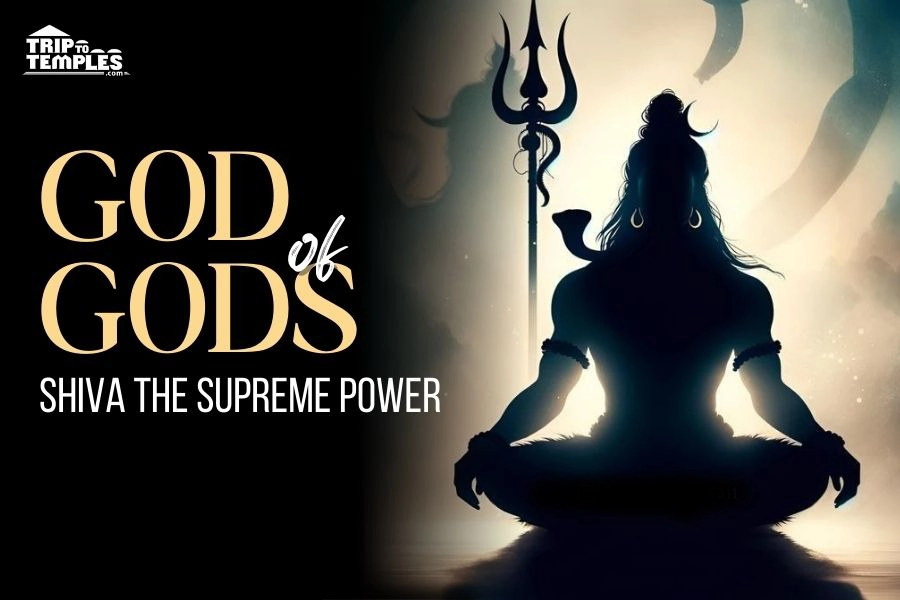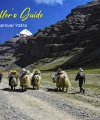Lord Shiva: The God of Gods 'Mahadev'
God of Gods SHIVA
Lord Shiva; the supreme power of the Universe, one of the Trimurti/Trinity (Brahma, Vishnu, Mahesh) in Hindu deity, the first yogi who is regarded to maintain good and destroy evil, is worshipped as the living God of Hindus and said to be the Mahadev- the God of Gods. Lord Shiva is also worshipped in the form of Ardhanarishwar (half-man and half-woman), where Shiva and his divine consort Parvati are symbolized together.
Shiva is worshipped as the most auspiciously followed Lord, but he is also the destroyer. The paradox of being a destroyer instead of a creator is a negative imagery of looking at the divine to worship seems the opposite of what wisdom means. The fact is that worshipping the destroyer in place of the creator states how the emergence of moksha or liberation happens only after destroying the limited forces.
Well, this is not done yet! Read the full page to learn more about Lord Shiva and his wonders according to the religious and spiritual context.
Who is Shiva?
Mahadeva or ‘The Great God’, popularly referred to as ‘Devon Ke Dev Mahadev’, ‘Bholenath’, and 'Mahakal' (implies beyond time and death), are some of the very common names of Lord Shiva. He is not just related to destruction but to regeneration and creation as well, both death and life. In Shiv Purana, he is represented as a great yogi or ‘Adiyogi’ (the first yogi), regarded both as the fierce God and the most magnanimous, as he’s worshipped by both the Asuras and the Devtas. Similarly, Lord Shiva has 19 avatars, some of them Veeabhadra, Bhairava, Durvasa, and Piplaad.
Modern science proves that everything that comes from nothing goes back to that nothing; based on this cosmological philosophy, the nothingness of the grand galaxies seems to be sprinkling like a star, and the rest is all vast space- and that’s Shiva, as said. The vastness of the space is referred to as the womb and the oblivion from where everything is born and taken back within, hence depicting Shiva generating and destroying every matter in the universe over time.
In an almost similar context, the lord is known as Neelkantha, one with the blue throat. The Vishkantha of Lord Shiva means one that holds venom/vish in his throat, signifying how he handles the poison of prejudice to complete his spiritual aggrandizement. Now forward, how did a creation like Lord Shiva, the ash-smeared vagabond who resides in the cemetery and wears a garland of skulls marry a princess- Sati, and start his family? To make this up, a fierce ascetic turned into a family man to share his competence with mankind, the Adiyogi moves from hostility to passion with life.
Moreover, Lord Shiva is worshipped in the form of a Shiv Linga or Lingam, where his existence is manifested in it. The self-manifested or Swayambhu Lingams are known as Jyotirlingas and there are 12 Jyotirlinga temples in India. Similarly, there are 1008 names of Lord Shiva and each name has a different meaning with certain energies associated with it. For instance, Rudra is the fierce avatar of Lord Shiva.
Continue reading to know more about the symbols of Lord Shiva and the mantras that help attain Shiv for a being.
Iconic symbols of Lord Shiva
Did you know? Lord Shiva’s iconic symbols carry profound meanings that are related to the Universe. Read on to learn about these spiritual yet iconic Symbols of Lord Shiva.
Crescent moon
Lord Shiva is also known as Chandrashekhar as he beautifully carries a crescent moon on his head. The Crescent Moon symbolizes the controller of his mind, and as Lord Shiva knows the emotions of every being on this Earth, it also symbolizes his control over time. Lord Shiva wears Chandra, or the moon, on his head because Chandra Dev was cursed by Daksha Prajapati. Seeking a remedy for the same from Lord Shiva, Chandra Dev asked for a boon. Shiva granted the same, with the Moon waning during Krishnapaksha and waxing during Shuklapaksha. The moon God represents ‘mind’, and Shiva himself knows everything about our mind and thoughts.
Trident
The Trident with a Damru represents the cycle of creation and destruction. Lord Shiva’s Trishul balances the energy axis of the universe, representing three gunas: Rajas, Tamas, and Sattva.
Third Eye
The third eye of Lord Shiva represents awakening, intuition, and wisdom involved in the metaphysical activity. However, the opening of Lord Shiva’s third eye leads to destruction, which signifies the virtue of justice. Hence he is also called ‘Trayambakam’, for context, he burnt the Kama into ashes with his third eye.
Snake
The snake wrapped around Lord Shiva’s neck is known as ‘Vasuki, ’ representing transformation and everything is transient in this universe. It also symbolizes healing and immortality.
Damru
The sound of Damru was the first sound in the universe called ‘Naad’, which is believed to be echoing in the entire Universe since its creation. Lord Shiva always holds a Damru in his hands, and the divine beats of the Damru represent the cosmic sound of the universe.
Nandi- the bull
Nandi- the bull who serves as the Vahana of Lord Shiva- depicts the epitome of faithfulness and virtue. Due to his loving and generously calm nature, Lord Shiva is also worshipped as Pashupatinath or ‘the Lord of animals’,
Rudraksha
Rudraksha is a semi-precious stone associated with Lord Shiva. A Rudraksha mala is used during Lord Shiva’s sacred mantra chanting. The reverberation energy of Rudraksha helps Yogis and its bearers, the power to attain a conducive spirituality. Rudraksha beads are known to have healing properties and are believed to have their origin from Shiva’s tears. Rudraksha is derived from two words- Rudra (Shiva) and Aksha (tears).
Bel patra
Lord Shiva’s love, blessings, and compassion can be easily attained by simply offering Bel Baptra and milk on the Shiv Lingam. If you are an ardent devotee of Lord Shiva, try planning the Kailash Mansarovar Yatra for your upcoming vacation and offer him the Bel leaves.
Shiv lingam
A Shivlingam is the source of existence, creation, and representation of Lord Shiva, the God of destruction and regeneration. Actually, Shiv is the union of creation (Prakriti) and pure consciousness (Purusha), defining the formless (nirakar) aspect of Lord Shiva. There are 12 Jyotirlingas and five Pancha-bhuta lingams that you must visit if you are a devotee of Lord Shiva. The Shivalingam’s structure is cylindrical, which symbolises the shape of the universe.
Bhasma
Lord Shiva’s shringar is done with bhasma, which symbolizes that everything is transient; anything that’s born has to be reduced to ashes someday. In Ujjain Mahakal Mandir, Mahakal or Shiva is worshipped with Bhasma Aarti procession, after which bel patra, datura leaves, bhang, etc, are offered at every Shiv Lingam. Lord Shiva is also known as Shamshana Adhipati (Lord of the cremation Ground), who likes to wear ashes, depicting his control over human life.
Neel-kantha
As the retention of Halahal from Amritamanthan or Samudra Manthan, a deadly poison, emerged from the ocean, which could have destroyed the universe. Lord Shiva (Bholenatha) consumed the poison to protect this universe and became Neelkantha Mahadev. After he consumed the poison, Maa Parvati stopped it in his throat, saving Shiva’s entire body from intoxication.
Ganga
Lord Shiva possesses the Ganges in his matted hair, which is why he is known as Gangadhar. Legends say, Ganga had to descend to Earth to purify the sins of King Bhagirath’s ancestors. Since the river currents could destroy the Earth, Lord Shiva decided to channelize the flow of the Ganges by releasing its water slowly from his hair.
Top sacred places to seek blessings of Lord Shiva
The revered places where Shiva is believed to be residing make it the most sacred pilgrimage site that magnifies all such possibilities of rekindling your spiritual journey. Here are the most popular pilgrimage destinations of Lord Shiva in India and beyond:-
1. Kailash Mansarovar Yatra
Hindu Scriptures and the ancient course of history confirm Kailash Mansarovar as the holy abode of Lord Shiva. Kailash Yatra Aerial Darshan or Kailash Mansarovar Parikrama in 2025 would be your call to take your spiritual journey with the divine power of Shiva.
2. Adi Kailash & Om Parvat Yatra
Also called the Chhota Kailash, a replica of Mount Kailash (Tibet), is located in Uttarakhand. Adi Kailash & Om Parvat Yatra by helicopter via Kathgodam or Delhi is one of the most trusted and efficient ways to explore the abode of Lord Shiva in India.
3. 12 Jyotirlinga Yatra
12 Jyotirlingas are called the Swayambhu Jyotirling, which is manifested by Lord Shiva himself. Start your spiritual journey with a circuit tour of 12 jyotirlingas throughout India with our well-curated Panch Jyotirlinga Yatra, Gujarat Jyotirlinga tour, and more.
4. Char Dham Yatra
The Char Dham Yatra refers to the four most religiously sacred pilgrimage destinations of Hindus, including Gangotri, Yamunotri, Kedarnath, and Badrinath where Lord Shiva blesses his devotees with divine peace.
5. Panch Kedar Yatra
The Shaivite sect of Hinduism tends to worship the Panch Kedar as 5 of the most revered pilgrimage destinations belonging to Lord Shiva. Kedarnath, Tungnath, Rudranath, Madhyamaheshwar, and Kalpeshwar Temples are the Panch Kedar’s elemental temples.
6. Panch Kailash Yatra
If we talk about the divine power of Shiva, Panch Kailash refers to the manifestation of Lord Shiva, erected as five mountains in the great Himalayan region. Elements of Panch Kailash are stated as Kailash Mansarovar, Adi Kailash, Kinnaur Kailash, Shrikhand Mahadev, and Manimahesh.
Know the five fundamental forms of Shiva
In Shaivite tradition, Shiva is known as the supreme God, the father of the universe, the most benevolent God, the one who fulfills the wishes of asuras, devtas, kinnars, bhoota, preta, ganas, and everyone else, and that’s why he is known as Ashutosh (who can be easily pleased).
Shiva is present in the five most vital aspects of this universe- the five elements, known here:
1. Yogeshwara: The first Yogi (Adiyogi)
Shiva is known as Adiyogi, the one who has all the yogic knowledge and has mastered all the senses. He is detached from all sorts of material things; however, still attached to the cosmic existence.
2. Bhuteshwara: The lord of the five elements
Bhuteshwara is another vital form of Shiva, where he rules all the five elements- earth, water, fire, air, and space. He plays the role of both the creator and the destroyer, something which is born, dissolves, and goes back to him.
3. Kaleshwara: Mahakal, the lord of time
Shiva, the Lord of time, the one who knows past, present, and future, and governs the time’s dimensions; it is where he’s believed to change destiny. This form of Shiva is worshipped in Ujjain’s Mahakal Mandir as ‘Mahakaleshwar’ (the lord of time). And with a single glimpse or darshan of Kaleshwara, every obstacle reduces to nothing but a void.
4. Sarveshwara: Vishwanath, the lord of the Universe
Shiva is Vishwanath or Sarveshwara, the one who is the lord of the universe, and Shiva represents everything in this universe that carries consciousness, as he is the source of life & existence. Thus, in Kashi Vishwanatha Temple, one of the 12 Jyotirlingas of a kind where he is prayed to in the form of the father of the universe.
5. Mahadeva: The Shambhava, the most magnanimous
In Hindu scriptures, Shiva is seen as the most innocent God or magnanimous, the Shambhava or Devon ke dev Mahadev. He is the caretaker of all and carries immense kindness and compassion, while fulfilling all the desires of his devotees easily.
Most powerful Shiv Mantras to remove obstacles in life
As per Hindu scriptures, Lord Shiva fulfills all the wishes of his devotees. The easiest and simplest mantra to please Lord Shiva is ‘Om Namah Shivaya, ’ believed to be one of the most powerful mantras that can eliminate negative energies from your life. It can remove all obstacles, and the mantra is supposed to give miraculous results. In addition, these are the most powerful mantras of Lord Shiva:
1. Mahamrityunjay Mantra
|| ॐ त्र्यम्बकं यजामहे सुगन्धिं पुष्टिवर्धनम् उर्वारुकमिव बन्धनान्मृत्योर्मुक्षीय मामृतात् ||
Meaning: Mahamrityunjaya Mantra is a prayer to the third-eyed Lord Shiva, who protects from untimely death, cures diseases, and suffering. Chanting this mantra offers moksha (liberation) from the human lifecycle.
2. Shiv Panchakshar Stotra
|| नागेन्द्रहाराय त्रिलोचनाय, भस्माङ्गरागाय महेश्वराय
नित्याय शुद्धाय दिगम्बराय, तस्मै नकाराय नमः शिवाय ||
Meaning: Shiv Panchakshar Stotra is a five-syllable mantra chanted in praise of Lord Shiva, who is present in all the five elements (earth, water, fire, air, and space). Each verse is a praise to the most benevolent God-Shiva.
3. Shiva Panchakshar Mantra
|| ॐ नमः शिवाय ||
Meaning: Chanting Om Namah Shivaye means paying salutations to the Great God Shiva. It is the easiest Shiva mantra that can eliminate all negative forces from one’s life and fulfill all desires.
Want to feel Mahadev's blessings more closely? Take a tirth yatra to Shiva’s abode with us. Call at +91-85100 07751 to learn more about Lord Shiva's holy abode- Kailash Mansarovar.
Also Read: 108 Names of Lord Shiva
Contact at +918510007751
Get in Touch
Have An Enquiry? Write To Us…
Related Packages
Related Blogs
Information Links and Downloads
Talk to Kailash Yatra Expert
Submit your contact number.
Kailash Yatra Expert will call You within 1 minute.
(24X7 Free Service, India Number only)
Get All Details on Mobile


Question and Answer
Related Packages

Overland Kailash Mansarovar Yatra 2026 by Bus
13 Night / 14 Days
- No extra charge for delays
- Darchen stay
- Panchang-based date
Stay Plan
- Kathmandu (2N)
- Dhunche (1N)
- Kyirong County (2N)
- Saga (1N)
- Lake Mansarovar (1N)
- Darchen (1N)
- Deraapuk (1N)
- Zutulpuk (1N)
- Dongba (1N)
- Kyirong County (1N)
- Kathmandu (1N)
EMI from ₹7639

Kailash Mansarovar Aerial Darshan
2 Night / 3 Days
- Special hawan pujan
- Lucknow-Nepalgunj by car
- 4 star hotel stay
Stay Plan
- Lucknow
- Nepalgunj(2N)
- Lucknow
EMI from ₹1611
Related Blogs

We Got Featured in the Media
Stay Connected for All Updates!
For the latest updates on Kailash Mansarovar Yatra, Adi Kailash Yatra
and other incredible travel destinations, make sure you’re following our channel

 WhatsApp
WhatsApp Instagram
Instagram
 Send
Send Comment
Comment





.webp?tr=w-100,h-120,f-webp)

.jpg?tr=w-100,h-120,f-webp)



.webp%3Ftr%3Dw-405%2Ch-270%2Cf-webp&w=750&q=80)

.jpg%3Ftr%3Dw-405%2Ch-270%2Cf-webp&w=750&q=80)














